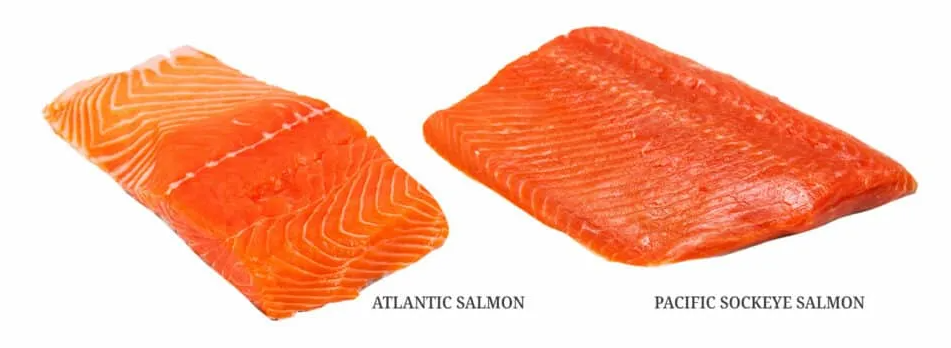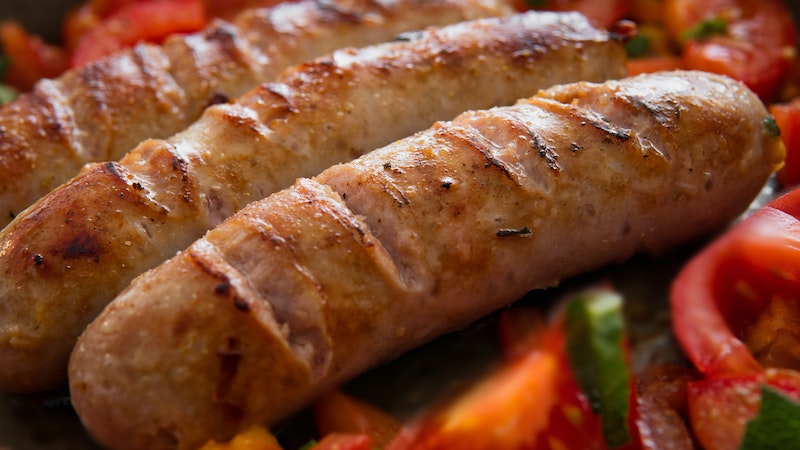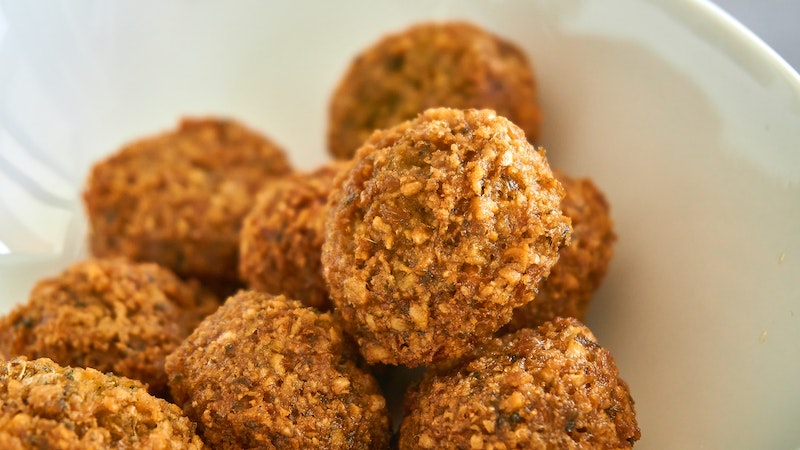
Contents
Salmon is a highly popular and nutritious seafood choice that comes in various species, each with its unique characteristics. Two of the most widely consumed types of salmon are sockeye (Oncorhynchus nerka) and Atlantic (Salmo salar) salmon.
Here, we will compare sockeye vs Atlantic salmon in terms of their physical and nutritional profiles, culinary uses, and sustainability considerations to help you make informed choices when selecting salmon for your next meal.
1. Physical Comparison
Sockeye Salmon (Oncorhynchus nerka):
- Size: Sockeye salmon are generally smaller in size compared to Atlantic salmon. They typically weigh between 4 to 15 pounds (1.8 to 6.8 kilograms) and measure about 18 to 31 inches (46 to 79 centimeters) in length.
- Color: Sockeye salmon have striking, deep red to orange-red flesh. Their skin is usually silver with a blue-green back, and during their spawning phase, their heads turn green and their bodies develop a humped shape.
- Body Shape: Sockeye salmon have a more streamlined and slender body shape, which is well-suited for swimming long distances in the open ocean. Their tails are narrow and deeply forked.
- Scales: They have relatively small, easily detachable scales.
- Fins: Sockeye salmon have a distinct dorsal fin with dark spots and no black or white margins.
Atlantic Salmon (Salmo salar):
- Size: Atlantic salmon are typically larger than sockeye salmon. They can range from 8 to 20 pounds (3.6 to 9.1 kilograms) or more and measure around 24 to 35 inches (61 to 89 centimeters) in length.
- Color: Atlantic salmon have a lighter pink to orange-colored flesh that is generally milder in flavor compared to sockeye salmon. Their skin is typically silver with black spots, and their coloration may change during different life stages and environments.
- Body Shape: Atlantic salmon have a more robust and less streamlined body compared to sockeye salmon. Their tails are broader and less deeply forked.
- Scales: They have relatively larger, firmly attached scales.
- Fins: Atlantic salmon have a dorsal fin with black and white margins, which is one of their distinguishing features.
2. Nutritional Comparison
Sockeye Salmon:
- Sockeye salmon is often referred to as “red” or “blueback” salmon due to its distinctive deep red flesh. This color comes from the carotenoid pigments in its diet, primarily from krill and plankton.
- It is an excellent source of high-quality protein, omega-3 fatty acids, and numerous essential vitamins and minerals.
- A 3.5-ounce (100g) serving of cooked sockeye salmon typically contains about 180 calories, 23 grams of protein, 9 grams of fat, and 1.5 grams of omega-3 fatty acids.
Atlantic Salmon:
- Atlantic salmon is known for its lighter pink to orange-colored flesh, which is often milder in flavor compared to sockeye salmon.
- Like sockeye salmon, it is rich in protein, omega-3 fatty acids, and essential nutrients.
- A 3.5-ounce (100g) serving of cooked Atlantic salmon generally contains approximately 206 calories, 22 grams of protein, 13 grams of fat, and 2.6 grams of omega-3 fatty acids.
Both types of salmon are healthy choices, as they provide essential nutrients, including vitamin D, vitamin B12, selenium, and various minerals. The slight variations in nutrient content are not significant, making either salmon a great addition to a balanced diet.
3. Culinary Uses
Sockeye Salmon:
- Due to its rich, vibrant color and bold flavor, sockeye salmon is a favorite for grilling and broiling. Its firm texture holds up well to high-heat cooking methods.
- Sockeye salmon’s strong flavor pairs wonderfully with complementary ingredients like citrus, herbs, and spices. It’s also excellent for sushi and sashimi preparations.
Atlantic Salmon:
- Atlantic salmon’s milder flavor and softer texture make it a versatile option for various cooking methods, including baking, poaching, and pan-searing.
- Its more subtle taste allows it to be easily infused with a wide range of seasonings and sauces, making it suitable for a broad spectrum of recipes and culinary traditions.
When choosing between sockeye vs Atlantic salmon for your meal, consider the flavor intensity you desire and the cooking method you plan to use, as this can influence your choice.
4. Sustainability Considerations
Sockeye Salmon:
- Sockeye salmon populations are generally considered healthier than Atlantic salmon populations. They are mainly found in the Pacific Northwest, where stricter regulations and better fisheries management practices have helped maintain sustainable stocks.
- The Marine Stewardship Council (MSC) has certified several sockeye salmon fisheries as sustainable, which can help consumers make environmentally conscious choices.
Atlantic Salmon:
- Atlantic salmon populations, especially those in the wild, have faced challenges due to overfishing, habitat degradation, and disease transmission from farmed salmon.
- To address sustainability concerns, there is an increased focus on responsible aquaculture practices for Atlantic salmon. Some Atlantic salmon farms are certified by organizations such as the Aquaculture Stewardship Council (ASC), which sets standards for environmentally and socially responsible aquaculture.
- PFAS-FREE & NON-TOXIC COOKWARE: Lodge cookware is made without PFOA and PTFE, and we’re proud to say our seasoned cast iron is made with just iron and oil, as it has been since the beginning.. We are committed to making products that are safe for you and the people around your table too. Every step in our manufacturing process is designed to protect our employees, the people who love our cookware, and the environment.
- ERGONOMIC ASSIST HANDLE & SILICONE PROTECTION: Equipped with an assist handle for easy control and a red silicone hot handle holder for a comfortable, safe grip, this skillet is easy to lift and maneuver. Ideal for storage or hanging when not in use, it combines functionality with durability.
- SEASONED COOKWARE FOR EASY COOKING: Lodge pre-seasons every pan with 100% natural vegetable oil, giving it a non-stick finish without synthetic chemicals. The more you use your skillet, the better the seasoning becomes for effortless cooking. synthetic chemicals. The more you use your skillet, the better the seasoning becomes for effortless cooking.
- VERSATILE COOKING FOR EVERY MEAL: Whether you’re searing, sautéing, baking, broiling, braising, frying, or grilling, this skillet handles it all. With superior heat distribution and retention, it ensures perfect, even cooking every time—whether on a stovetop, grill, or campfire.
That’s all the comparison between sockeye vs Atlantic, both salmons offer exceptional nutritional benefits and are delicious additions to your diet. Your choice between the two can depend on your flavor preferences and the cooking method you plan to use.
Additionally, considering the sustainability of the salmon you purchase is important for the health of our oceans and the future of these remarkable fish. Whether you opt for the rich, red sockeye or the milder Atlantic salmon, you can savor the unique qualities each type brings to your table while making informed choices to protect the environment.








